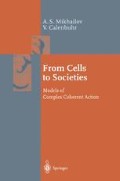Abstract
Life is so complex and diverse that the mere possibility of its mathematical modeling is sometimes denied. Nonetheless, there are many successful models of biological and social systems. The common property of many such models is that they treat an individual organism, a cell or an animal, as an automaton. An automaton is essentially a ‘black box’ which receives information and generates an output, choosing it from a fixed repertoire. Hence, it is described by specifying a set of mapping rules that must be applied to generate responses for various combinations of incoming signals.
Access this chapter
Tax calculation will be finalised at checkout
Purchases are for personal use only
Preview
Unable to display preview. Download preview PDF.
References
C.J. Romanes, “Preliminary observations on the locomotor system of meduse”, Phil. Trans. Roy. Soc. CLXVI, 269 (1876)
A.G. Mayer, “Rhythmical pulsation in scyphomeduse”, Papers from the Tortugas Laboratory, Washington, I, 115–131 (1908)
C.R. Mines, “On dynamic equilibrium in the heart”, J. Physiol. XLVI, 349 (1913)
Th. Lewis, The Mechanism and Graphic Registration of the Heart Beat, 3rd edn. (Shaw and Sons, London 1925)
W. Garrey, “The nature of fibrillary contraction of the heart. Its relation to tissue mass and form”, Amer. J. Physiol. 23, 397 (1914)
N. Wiener, A. Rosenblueth, “The mathematical formulation of the problem of conduction of impulses in a network of connected excitable elements, specifically in cardiac muscle”, Arch. Inst. Cardiol. Mexico 16, 205 (1946)
A.S. Mikhailov, V.S. Zykov, Sov. Phys. — Dokl. 31, 51 (1986)
A.S. Mikhailov, Foundations of Synergetics I. Distributed Active Systems, 2nd edn. (Springer, Berlin, Heidelberg 1994)
D.A. Kessler, H. Levine, Phys. Rev. E 48, 4801 (1993)
H. Levine, Phys. Rev. Lett. 66, 2400 (1991)
B.N. Vasiev, P. Hogeweg, A.V. Panfilov, Phys. Rev. Lett. 73, 3173 (1994)
Th. Höfer, Ph.K. Maini, Phys. Rev. E 56, 2074 (1997)
A. Huth, Ch. Wissel, J. Theor. Biol. 156, 365 (1992)
A. Huth, Ch. Wissel, Comm. Theor. Biol. 3, 169 (1993)
A. Huth, Ch. Wissel, Ecol. Modeling 75/76, 135 (1994)
E.O. Wilson, The Social Insects (Belknap Press, Cambridge, MA 1971)
C.J. Lumsden, B. Hoelldobler, J. Theor. Biol. 100, 81 (1983)
J.L. Deneubourg, S. Goss, Ethology, Ecology and Evolution 1, 295 (1989)
J.L. Deneubourg, G. Theraulaz, R. Beckers, “Swarm Made Architectures”, In Towards a Practice of Autonomous Systems, Proc. First European Conf. on Artificial Life, eds. F.J. Varela, P. Bourgine (MIT Press/Bradford Books, Cambridge, MA 1992) p. 123
J.L. Deneubourg, S. Goss, N. Franks, A. Sendova-Franks, C. Detrain, L. Chretien. “The Dynamics of Collective Sorting: Robot-like Ants and Ant-like Robots”, In Simulation of Animal Behaviour: From Animals to Animats, eds. J.A. Meyer, S. Wilson (MIT Press, Cambridge, MA 1991) p. 356
J.L. Deneubourg, S. Aron, S. Goss, J.M. Pasteels, J. Ins. Behav. 3, 159 (1990)
S. Goss, S. Aron, J.L. Deneubourg, J.M. Pasteels, Naturwissenschaften 76, 579 (1989)
V. Calenbuhr, J.L. Deneubourg, J. Theor. Biol. 158, 359 (1992)
V. Calenbuhr, J.L. Deneubourg, J. Theor. Biol. 158, 394 (1992)
V. Calenbuhr Collective Behaviour in Social and Gregarious Insects: Chemical Communication and Self-Organization. Ph.D. Thesis, Free University of Brussels (1992)
V. Braitenberg, Vehicles — Experiments in Synthetic Psychology (MIT Press, Cambridge, MA 1984)
R.A. Brooks, AI Journal 47, 139 (1991)
H. Asama, T. Fukuda, T. Arai, I. Endo (eds.), Distributed Autonomous Robotic Systems 2 (Springer, Berlin 1996)
T. Lueth, R. Dillmann, P. Dario, H. Wörn (eds.), Distributed Autonomous Robotic Systems 3 (Springer, Berlin 1998)
N.R. Franks, Am. Sci. 77(2), 138 (1989)
R. Jander, K. Daumer, Insectes Sociaux 21, 45, (1974)
W. Hangartner, Z. vergl. Physiol. 57, 103 (1967)
R.H. Leuthold, “Orientation Mediated by Pheromones in Social Insects”, In Pheromones and Defensive Secretions in Insects, eds. C. Noirot, P.E. Howse, J. Le Masne (University of Dijon Press, Dijon 1975) p. 197
G.F. Oster, E.O. Wilson, Caste and Ecology in the Social Insects (Princeton University Press, Princeton, NJ 1978)
B. Hölldobler, E.O. Wilson, The Ants (Springer, Berlin, Heidelberg 1990)
M.H. Hansell, Animal Architecture and Building Behaviour (Longman, London 1984)
P.-P. Grasse, Insectes Sociaux 6, 41 (1959)
J.D. Murray, Mathematical Biology (Springer, Berlin, Heidelberg 1989)
I.S. Balakhovskii, Biophysics 10, 1175 (1965)
S.A. MacKay, J. Cell Sci. 33, 1 (1978)
G.K. Moe, W.C. Rheinboldt, J.A. Abildskov. Am. Heart J. 67, 200 (1964)
O. Selfridge, Arch. Inst. Cardiol. Mexico 18, 177 (1948)
J.M. Smith, R.J. Cohen, Proc. Nat. Acad. Sci. USA 81, 233 (1984)
M. Markus, B. Hess, Nature 347, 56 (1990)
J.R. Weimar, J.J. Tyson, L.T. Watson, Physica D 55, 302 (1992)
J.R. Weimar, J.J. Tyson, L.T. Watson, Physica D 55, 328 (1992)
E.F. Codd, Cellular Automata (Academic Press, New York 1966)
S. Wolfram, Physica D 10, 1 (1984)
C.G. Langton, Physica D 10, 135 (1984)
E.R. Berlekamp, J.H. Conway, R.K. Guy, Winning Ways (Academic Press, London 1982)
M. Gardner, Sci. Am. 223, 120 (1970);
M. Gardner, Sci. Am. 224, 112 (1971);
M. Gardner, Sci. Am. 224, 117 (1970)
J. von Neumann, In The Theory of Self-Reproducing Automata, edited and completed by A.W. Burks, (University of Illinois Press, Champaign, IL 1966)
A.W. Burks (ed.), Essays on Cellular Automata (University of Illinois Press, Champaign, IL 1968)
M. Gerhardt, H. Schuster, J.J. Tyson, Physica D 46, 392 (1990)
D. Young, Math. Biosciences 72, 51 (1984)
C. Burks, D. Farmer, Physica D 10, 157 (1984)
A. Lindenmayer, J. Theor. Biol. 30, 455 (1967)
R. Axelrod, The Complexity of Cooperation: Agent Based Models of Competition and Collaboration Intelligence (Princeton University Press, Princeton, NJ 1997)
I. Aoki, Bull. Ocean. Res. Inst. University Tokyo 12, 1 (1980)
Author information
Authors and Affiliations
Rights and permissions
Copyright information
© 2002 Springer-Verlag Berlin Heidelberg
About this chapter
Cite this chapter
Mikhailov, A.S., Calenbuhr, V. (2002). The Games of Life. In: From Cells to Societies. Springer Series in Synergetics. Springer, Berlin, Heidelberg. https://doi.org/10.1007/978-3-662-05062-0_2
Download citation
DOI: https://doi.org/10.1007/978-3-662-05062-0_2
Publisher Name: Springer, Berlin, Heidelberg
Print ISBN: 978-3-642-07574-2
Online ISBN: 978-3-662-05062-0
eBook Packages: Springer Book Archive

